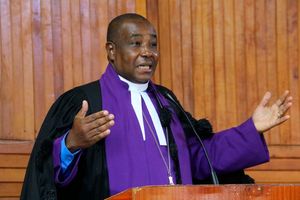Premium
Covid-19: How a microbe has unmasked Africa’s bankruptcy of governance

An illustration image obtained February 27, 2020, courtesy of the US Food and Drug Administration, shows the coronavirus.
What you need to know:
- On the whole, however, East Africa’s governments have done the right things with regards to their efforts to contain the spread of the virus.
- They have also been trying to perform tests to confirm suspected cases as much as national testing facilities have been able to afford.
- Sadly, these measures are hampered by the total focus on copying the experiences of countries in Asia and Europe but with limited effort to tweak them for the unique circumstances of each country.
- And implementation is already showing signs that if East African governments do not exercise caution this could lead to even more disastrous situations.
So far, coronavirus has been slow to spread across Africa, but this has not been a function of any actions the governments have taken. The measures to contain the spread of Covid-19 have not been linked to the low rates on the continent, even as these measures are proving so draconian as to risk mass protests throughout the region.
On the whole, however, East Africa’s governments have done the right things to contain the spread of the virus. They have ordered closure of markets, religious ceremonies, funerals and other crowd gatherings.
They have tried to perform tests to confirm suspected cases as much as national testing facilities have been able to afford. They’ve announced evening curfews, regulated public transit, advised social isolation and self-quarantining, all with an eye to achieving physical separation between people in order to curb transmission.
Sadly, these measures are hampered by the total focus on copying the experiences of countries in Asia and Europe with limited effort to tweak them for the unique circumstances of each country.
Borrowing ideas and taking lessons from other countries is all very important and inescapable. African countries have shown that social context in a given country can impede a health intervention that is effective elsewhere.
These imported lessons were copied wholesale and they have been applied wrongly in many instances.
CHINESE SUCCESS
This has already begun to make the measures look more deadly than the disease they’re trying to combat, at least in the eyes of the general public. For example, East Africa’s public health authorities and medical professionals seem to correctly understand that enforcing physical distancing was the primary piece in the Chinese success in containing the virus.
There was no magic in that, just logic, given the knowledge about how the virus is transmitted. This is the most effective measure to prevent, contain and mitigate the pandemic.
But its implementation shows East Africa has to exercise caution or this could lead to disaster, where the measures will not stop the spread of the disease while imposing such severe economic hardships on the population that it leads to malnutrition and starvation for thousands of people.
The way East African governments have applied physical distancing measures has unmasked the poverty of innovation inherent in the way East Africans are governed, with brutality, disdain, callousness and further endangerment of lives.
Nowhere in this day and age has the police demonstrated such contempt for the people it was established to protect than what the streets of Nairobi and Kampala have witnessed in recent days.
Such violence involving police attacks on citizens, yanking people off moving motorcycle transports (boda boda), whipping journalists, breaking cameras, engaging in hand duels with street vendors and demolishing markets in such a manner as to churn one’s stomach, have all been contrary to physical distancing measure.
The police have violently engaged in close physical contact with the public, risking spreading the virus, as if they think they are themselves immune to the disease.
What started as a response to save people from a deadly disease has begun to show signs of a confrontation between government agencies and a people who’ve detected a lack of empathy from public officials.
Take for example, the management of curfew in view of the public transit challenges in Kenya’s major cities.
It is a known fact that millions of Kenyans simply can’t stop working or they will die of hunger. When a curfew is instituted banning movement after 7pm and people have to catch the last ferry in Mombasa at 6pm, everybody streaming out of work at 5pm will scramble for that last ferry and squeezing onto it like sardines, what function does that curfew really serve?
These absurd measures will trigger public anger, which will not be contained, not by fear of disease and not by threats of bullets, and it will not stop at challenging the coronavirus measures. This will be a turning point in East African peoples’ claim to their civic space.
TESTING
Physical separation measures are followed in importance by testing, so that the country knows the true disease prevalence.
But in East Africa, as it is in much of the continent, countries’ capacity for quality control validation processes for each and every test that they conduct is not in place. Testing kits being used in East Africa now include those provided by Alibaba Chairman, Chinese billionaire, Jack Ma.
Some of these kits have been associated with false negatives, and they’re being used with caution by healthcare systems in the world’s biggest economies. False negative Coronavirus test results in any of East African countries would only further compromise the already weak health systems.
The reality in some of these countries, South Sudan, Kenya and Uganda, is that projections and scenario developments are focused on the likelihood of massive increase in the rates of infection and what the country would do in medical terms.
But this is no longer just a medical problem. It’s also an economic and social disease. However, no one is talking about any scenarios regarding the economic real impact of total shutdown.
Instead, and because response measures were all borrowed, governments would rather drive this coronavirus response in the dark, hoping people won’t notice the incompetence cloaked in violence.
This disease is, however, laying bare the ruthlessness, the move away from citizen-centred public policy and the insidious and corrupt elitism that undergirds all that.
In Juba, South Sudan, buses were ordered to run at half capacity to maintain physical distancing, but crowds of desperate people gather in bus parks, pushing and shoving in competition for seats on the bus, all frustrating people while not attaining social distancing objective.
In Kampala, closing shopping malls is understandable, but why shut small shops that are the lifeline of neighbourhoods, both for the owners and the consumers, if this is not to simply institute blanket policies no one has bothered to think through?
Analysing the economic impact to see if the suffering caused by the shutdown outweighs the impact of the disease is not to downplay the aggressive nature of the pandemic.
This is a disease that will kill a lot of people, especially in Africa, where health services are overwhelmed. The point is that these measures don’t apply in the same way in different countries.
The Chinese managed social distancing in ways that are congruent with their traditions and political culture, hence their success. In East Africa, it should not be an all-or-nothing measure.
Enforcing physical distancing doesn’t have to be draconian as to suggest ordinary people are unfearful, careless and have to be coerced with brutality. People are generally afraid of disease and providing them with information about what contact to avoid is enough to prevent infections.
The author is a professor of anthropology at Maxwell School of Citizenship and Public Affairs, Syracuse University.





